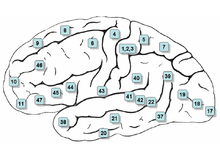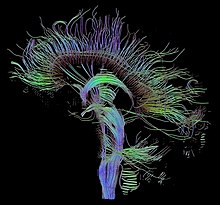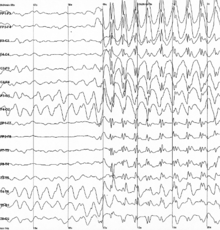Neurolinguistics
[1] Neurolinguistics is historically rooted in the development in the 19th century of aphasiology, the study of linguistic deficits (aphasias) occurring as the result of brain damage.
Phrenologists had made the claim in the early 19th century that different brain regions carried out different functions and that language was mostly controlled by the frontal regions of the brain, but Broca's research was possibly the first to offer empirical evidence for such a relationship,[4][5] and has been described as "epoch-making"[6] and "pivotal"[4] to the fields of neurolinguistics and cognitive science.
[2][3] The work of Broca and Wernicke established the field of aphasiology and the idea that language can be studied through examining physical characteristics of the brain.
[8] The coining of the term neurolinguistics in the late 1940s and 1950s is attributed to Edith Crowell Trager, Henri Hecaen and Alexandr Luria.
[9] Although aphasiology is the historical core of neurolinguistics, in recent years the field has broadened considerably, thanks in part to the emergence of new brain imaging technologies (such as PET and fMRI) and time-sensitive electrophysiological techniques (EEG and MEG), which can highlight patterns of brain activation as people engage in various language tasks.
[12][13] The N400 was the first language-relevant event-related potential to be identified, and since its discovery EEG and MEG have become increasingly widely used for conducting language research.
[14] Neurolinguistics is closely related to the field of psycholinguistics, which seeks to elucidate the cognitive mechanisms of language by employing the traditional techniques of experimental psychology.
Much work in neurolinguistics has, like Broca's and Wernicke's early studies, investigated the locations of specific language "modules" within the brain.
[29] Neurolinguistic techniques are also used to study disorders and breakdowns in language, such as aphasia and dyslexia, and how they relate to physical characteristics of the brain.
[23][27] Since one of the focuses of this field is the testing of linguistic and psycholinguistic models, the technology used for experiments is highly relevant to the study of neurolinguistics.
Modern brain imaging techniques have contributed greatly to a growing understanding of the anatomical organization of linguistic functions.
[33] Electrophysiological techniques take advantage of the fact that when a group of neurons in the brain fire together, they create an electric dipole or current.
These techniques are able to measure brain activity from one millisecond to the next, providing excellent temporal resolution, which is important in studying processes that take place as quickly as language comprehension and production.
[34] On the other hand, the location of brain activity can be difficult to identify in EEG;[31][35] consequently, this technique is used primarily to how language processes are carried out, rather than where.
These techniques include the subtraction paradigm, mismatch design, violation-based studies, various forms of priming, and direct stimulation of the brain.
[37][42] It is an electrophysiological response that occurs in the brain when a subject hears a "deviant" stimulus in a set of perceptually identical "standards" (as in the sequence s s s s s s s d d s s s s s s d s s s s s d).
[20] Another common use of violation designs is to combine two kinds of violations in the same sentence and thus make predictions about how different language processes interact with one another; this type of crossing-violation study has been used extensively to investigate how syntactic and semantic processes interact while people read or hear sentences.
[55] Priming is used to investigate a wide variety of questions about how words are stored and retrieved in the brain[54][56] and how structurally complex sentences are processed.




